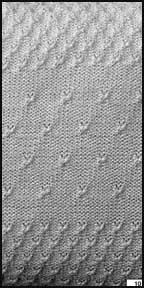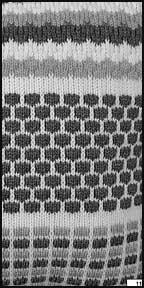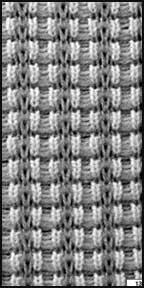|
Information on Tuck and Tuck Lace:
• set russel levers to I
• knit at MT-1
• a tucked stitch is formed when the needle does not go back far enough to pull the new yarn through the old stitch; both remain on the needle until the leading russel lever is set to II, then a knit stitch is formed over all the loops
• two adjacent needles can not tuck on the same row
• the more tucked stitches, the wider, shorter and thicker the fabric will be and the more yarn will be needed
• in tuck lace, the more needles removed from work, the narrower the fabric will be
• the purl side is usually the right side; but sometimes the knit side is better, especially in multi-coloured tuck
• do not tuck on the edge stitches
• before binding off, fill any empty needles with a bar from an adjacent stitch and knit 1 row over it to keep the bind-off edge the same width as the cast-on edge
• when binding off, be sure to knit all the stitches on the row before
Hints on knitting Tuck Stitches:
• tuck stitches require more weight than most stitches; be sure to use the cast-on comb
• if going into tuck right at the beginning of a piece, it may be necessary to knit at least one inch of waste yarn and one row of ravel cord to provide more weight
• it may be necessary to pull all the needles to D position on the first knit row of each pattern repeat so that all the stitches knit off properly
|
|





